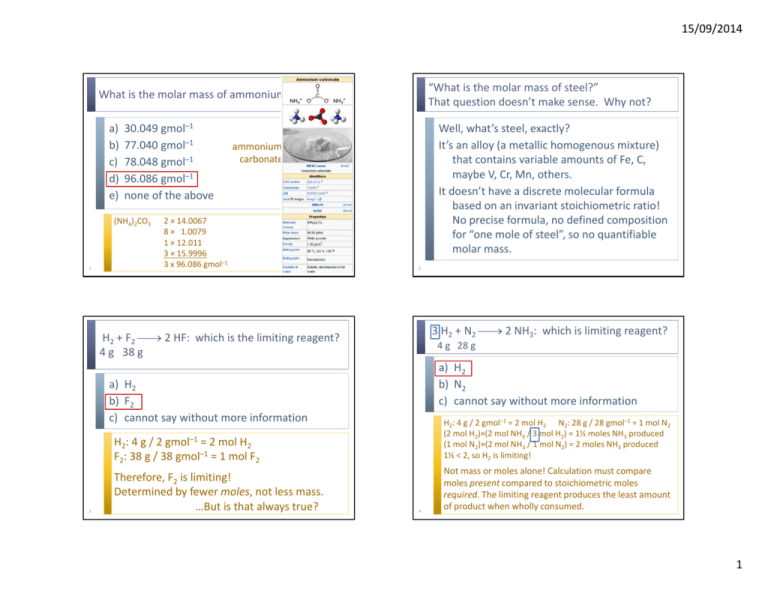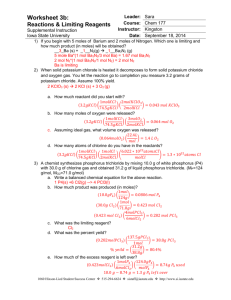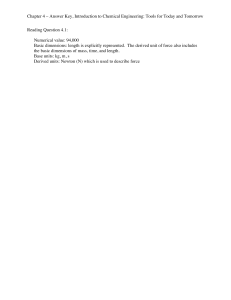What is the molar mass of ammonium carbonate? a) 30.049 gmol–1
advertisement

15/09/2014 “What is the molar mass of steel?” That question doesn’t make sense. Why not? What is the molar mass of ammonium carbonate? a) b) c) d) e) 30.049 gmol–1 77.040 gmol–1 78.048 gmol–1 96.086 gmol–1 none of the above (NH4)2CO3 1 Well, what’s steel, exactly? It’s an alloy (a metallic homogenous mixture) that contains variable amounts of Fe, C, maybe V, Cr, Mn, others. It doesn’t have a discrete molecular formula based on an invariant stoichiometric ratio! No precise formula, no defined composition for “one mole of steel”, so no quantifiable molar mass. ammonium = [NH4]+ carbonate = [CO3]2– 2 × 14.0067 8 × 1.0079 1 × 12.011 3 × 15.9996 3 x 96.086 gmol–1 2 3 H2 + N2 ⎯→ 2 NH3: which is limiting reagent? H2 + F2 ⎯→ 2 HF: which is the limiting reagent? 4 g 38 g 4 g 28 g a) H2 b) N2 c) cannot say without more information a) H2 b) F2 c) cannot say without more information 3 H2: 4 g / 2 gmol–1 = 2 mol H2 F2: 38 g / 38 gmol–1 = 1 mol F2 H2: 4 g / 2 gmol–1 = 2 mol H2 N2: 28 g / 28 gmol–1 = 1 mol N2 (2 mol H2)×(2 mol NH3 / 3 mol H2) = 1⅓ moles NH3 produced (1 mol N2)×(2 mol NH3 / 1 mol N2) = 2 moles NH3 produced 1⅓ < 2, so H2 is limiting! Therefore, F2 is limiting! Determined by fewer moles, not less mass. …But is that always true? Not mass or moles alone! Calculation must compare moles present compared to stoichiometric moles required. The limiting reagent produces the least amount of product when wholly consumed. 4 1 15/09/2014 1.00 mol Ca(CN2) and 1.00 mol H2O are reacted to produce calcium carbonate and ammonia. Approximately how much ammonia is obtained? a) b) c) d) e) Which is the limiting reagent? What is the % yield? 3 moles limiting reagent: 2 moles produces the least amount of between 1 and 2 moles product when 1 mol wholly consumed < 1 mol Ca(CN2) + 3 H2O ⎯→ 1 ⎯→ 1 ⎯→ 5 2.36 g of GeCl4 (MM = 214.40) is reacted with 318 mg of LiH (MM = 7.95). 0.625 g of GeH4 (MM = 76.62) is isolated. a) GeCl4 b) LiH c) GeH4 d) LiCl e) there is no limiting reagent Balance the reaction! GeCl4 + 4 LiH ⎯→ 4 LiCl + GeH4 CaCO3 + 2 NH3 2 2/3 6 Moles GeCl4 = (2.36 g)/(214.40 gmol–1) = 11.0 mmol / 1 = 11 Moles LiH = (0.318 g)/(7.95 gmol–1) = 40.0 mmol / 4 = 10 LiH is limiting! 2








